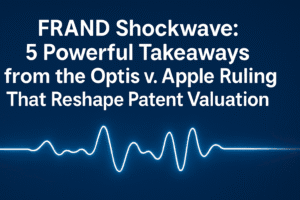FRAND Shockwave: 5 Powerful Takeaways from the Optis v. Apple Ruling That Reshape Patent Valuation
The UK Court of Appeal’s landmark Optis v. Apple decision fundamentally reshapes FRAND licensing disputes. It forcefully rejected a trial judge’s creation of his own valuation methodology, deeming it procedurally unfair and ungrounded in evidence. Instead, the ruling emphatically restored the primacy of real-world, comparable licences – actual market agreements involving similar patents and contexts – as the essential foundation for determining fair royalties. Courts must respect the necessity of expert analysis, including legitimate techniques to “unpack” lump sums for comparison, and cannot substitute untested economic theories.
Crucially, the decision underscores that procedural fairness is non-negotiable; parties must have full opportunity to scrutinize and challenge evidence. This ruling hands responsibility firmly back to SEP holders and implementers: robust, well-documented licensing evidence and good-faith negotiation are paramount, as courts will no longer invent solutions where parties fail to provide compelling market-based proof. The verdict demands valuation grounded in commercial reality, not judicial intuition, bringing essential predictability to complex SEP litigation.

FRAND Shockwave: 5 Powerful Takeaways from the Optis v. Apple Ruling That Reshape Patent Valuation
The UK Court of Appeal’s landmark decision in Optis v. Apple isn’t just another patent ruling. It’s a powerful reaffirmation of a fundamental truth in complex technology litigation: the parties, not the judge, must drive the evidence. This verdict fundamentally reshapes how Fair, Reasonable, and Non-Discriminatory (FRAND) licenses for Standard Essential Patents (SEPs) will be valued in the UK, moving away from judicial intuition and firmly back towards commercial reality.
The Core Dispute: Who Decides Value?
At its heart, the case revolved around valuing Optis’s 4G (LTE) SEPs used in Apple products. Optis pointed to its license with Google. Apple countered with its own history of lump-sum deals. The trial judge, dissatisfied with both sides’ evidence and expert analyses, took an unprecedented step: he invented his own valuation methodology.
- He averaged numerous licenses (including Apple’s deals with others).
- He applied Optis’s estimated 0.38% share of the total patent “stack.”
- He arrived at a global lump sum of $56.43 million – a figure neither party advocated for.
The Appeal: Rejecting Judicial Overreach
The Court of Appeal didn’t just disagree with the outcome; it soundly rejected the trial judge’s entire approach as procedurally unfair, evidentially unsupported, and flawed in principle.
- Primacy of Real-World Comparables: The Court slammed the door on judges creating homemade economic models. “Robust comparable licences” are king. These must be deals involving the same SEP portfolio, covering similar technology, scope, and negotiated in a comparable commercial context. Judicial discretion is for interpreting evidence, not replacing it with untested theories.
- Legitimizing “Unpacking”: Lump-sum deals are common, but comparing them directly to per-unit royalties is like comparing apples to oranges. The Court endorsed “unpacking” – converting lump sums into equivalent per-unit rates (using methods like free-release discounts, simple discounts, or blended rates). Rejecting expert “unpacking” evidence, as the trial judge did, was a fundamental error. While imperfect, it’s a necessary tool for meaningful comparison.
- Flexibility in Royalty Structures: The ruling confirmed there’s no single “right” way to structure FRAND royalties. Lump sums, fixed per-unit rates (DPU), or percentages (ad valorem) can all be valid. The appropriate format depends on industry practice and the implementer’s business model. Neither Optis’s demand for ad valorem nor Apple’s rigid insistence on DPU was inherently correct.
- Procedural Fairness is Paramount: The trial judge’s averaging method involved subjective assumptions and “cherry-picking” data points. Crucially, the parties had no chance to scrutinize or challenge this methodology. This violated the basic right to a fair hearing and adversarial testing of evidence.
- Experts Matter: Complex commercial licenses demand expert analysis. Courts cannot dismiss expert valuation evidence simply because it involves judgment calls. Judges need this specialized input; they cannot substitute their own economic intuitions, especially in highly technical SEP/FRAND disputes.
- Negotiating Behavior Scrutinized: The Court noted both parties adopted inflexible positions during negotiations. This serves as a stark reminder that good faith and willingness to reach agreement on FRAND terms are critical. Extreme positions can harm a party’s credibility and case.
Why This Matters: Clarity, Predictability, and Responsibility
The Optis v. Apple decision sends a clear message to the entire SEP ecosystem:
- For SEP Holders (Licensors): Your strongest weapon is a well-documented history of robust, comparable licenses. Vague theories or aggressive hold-up tactics won’t suffice. Base your offers firmly in established market practice.
- For Implementers (Licensees): Relying solely on your own past deals or adopting rigid “hold-out” positions is risky. Engage in good faith negotiations and be prepared to justify your valuation using credible comparables and expert analysis.
- For Everyone: Litigation is not a shortcut for poor preparation. UK courts will no longer invent solutions when parties fail to present compelling, real-world evidence. Thorough, evidence-based cases built on market realities are paramount. Judges will interpret, not invent.
The Road Ahead: Grounding Innovation in Commercial Reality
As battles over 5G, AI, and IoT SEPs intensify, the Optis v. Apple ruling stands as a crucial landmark. It re-centers FRAND valuation on the bedrock of actual market agreements, interpreted transparently and tested fairly. It demands rigor from litigants and restraint from the bench. This shift towards predictability and commercial grounding is not just a legal technicality; it’s essential for fostering the innovation these very standards aim to enable. The message is clear: When it comes to valuing the invisible engines of our tech-driven world, the market’s voice, presented rigorously by the parties, must lead the way.
You must be logged in to post a comment.